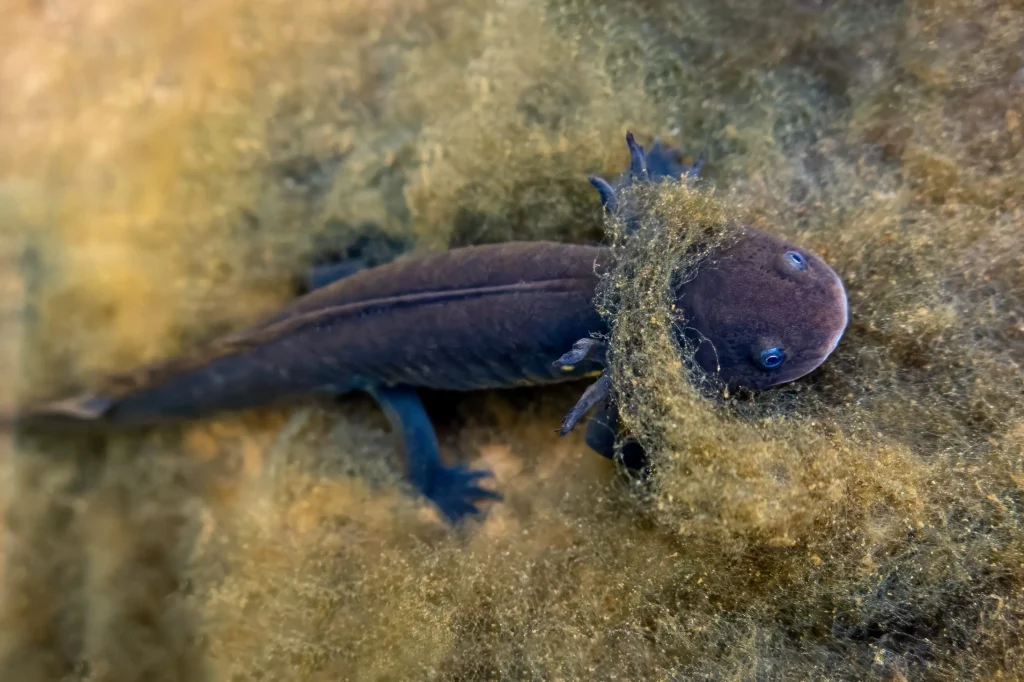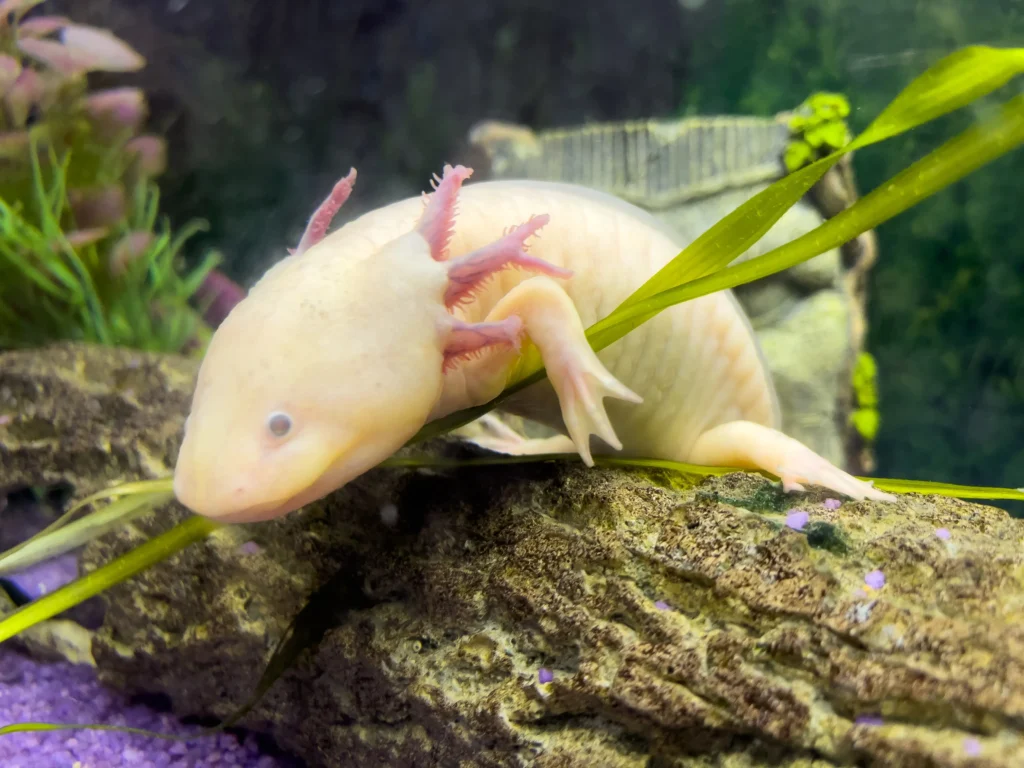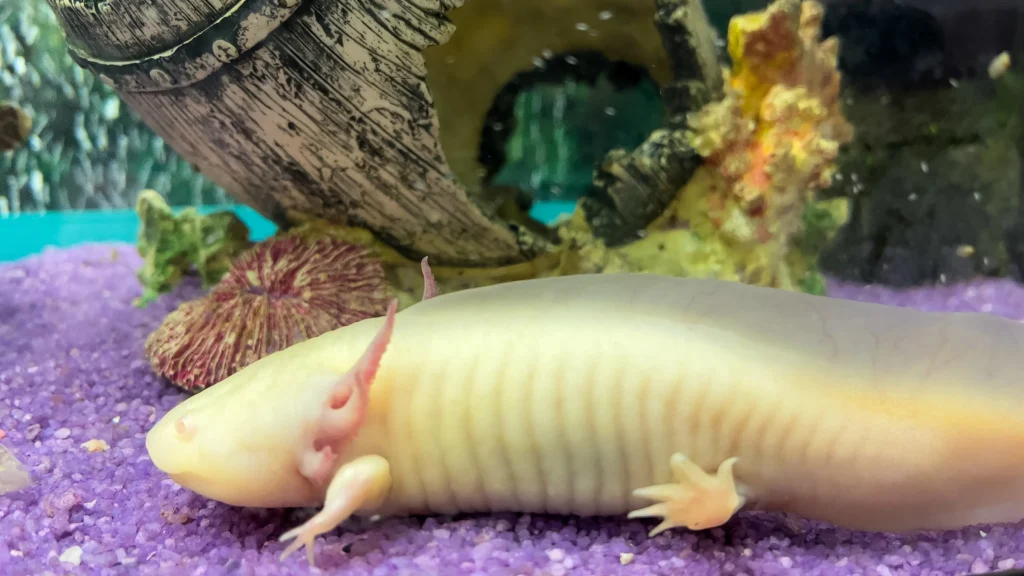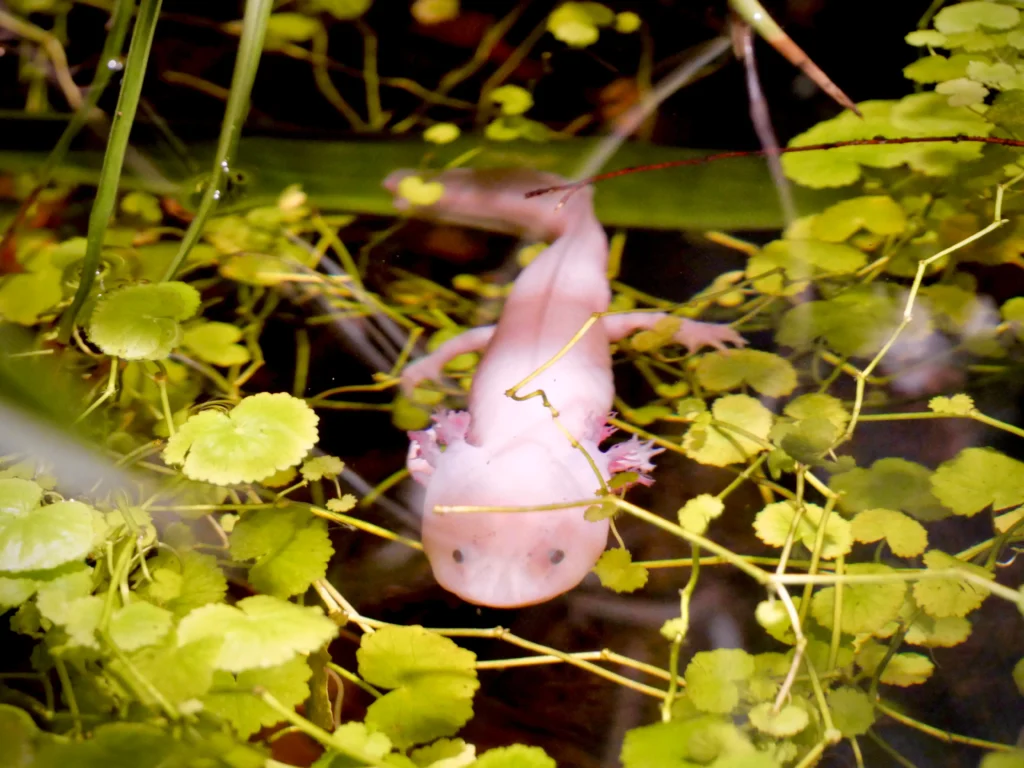Introduction to Axolotls: Nature’s Neotenic Wonder
Axolotl (Ambystoma mexicanum) is a paedomorphic aquatic creature. These are native to Mexico and disguise themselves as salamanders. Axolotls are popular due to their fascinating features and incredible regenerative abilities. They can regrow their tail, limbs, spinal cord, heart, and even parts of their brain.
Due to their remarkable ability to regenerate body parts, axolotls are of great importance in medical research. Scientists are experimenting with axolotl genes that can regenerate to determine if humans can do the same in the future.
Despite being popular and having incredible abilities, the wild axolotls (not pet ones) are endangered animals. The primary reasons for their population decline are poaching, habitat destruction, and the introduction of invasive species, such as carp and tilapia, which have limited the wild population to only a few hundred axolotls. Scientists have reported that there are more axolotls in aquariums or laboratories than in the wild.
The decline in the axolotl population is causing an imbalance in the ecosystem in the wild. As they are a keystone species in their native habitat of Xochimilco and Lake Chalco, Mexico City, they play a crucial role in maintaining the balance of the food web. Axolotls are carnivores that feed on small fish, insects, and crustaceans. Therefore, controlling their population in specific areas.
Today, axolotls are found in the water remains of ancient lakes of Xochimilco, Mexico City.
In the late 1990s, scientists reported that there were 6,000 axolotls per square kilometer in Xochimilco, which declined by 36 axolotls per square kilometer within two decades. In 2019, it was estimated that there were 50-1000 individual axolotls found in natural habitats.
Table of Contents
Axolotl’s Journey from Ancient Times to Your Water Tank
All pet or captive axolotls are traced back to 33 specimens that were shipped from Xochimilco to the Paris Zoo in 1864. Pet axolotls are reproduced in controlled environments and produce mutated offspring. In the wild, axolotls are black or brown, but due to a mutation, the axolotl changes color to pink or white.
The word axolotl has great significance in ancient times, as it has Aztec roots. Nahuatl was the language of the Aztec people in present-day Mexico City, which was known as Tenochtitlan. Axolotl comes from the word “Xolotl,” which means god of fire, lightning, and death. According to some people, “atl” means water, and “xolotl” means dog. Thus, axolotl means water dogs.
Why is the Axolotl Life Cycle So Interesting?
Neoteny and Life in Water:
Apart from historical myths, axolotls have some unique characteristics. Neoteny, retaining larval features in adulthood and becoming sexually mature in a larval state. This characteristic makes them look cute for a lifetime. Unlike other amphibians that undergo metamorphosis and adapt to terrestrial life, axolotls remain aquatic under natural conditions.
Paedomorphosis is controlled by the brain, which releases the hormone. Typically, they lose the ability to produce a thyroid-stimulating hormone that triggers metamorphosis, so they stay aquatic for a lifetime.
This adaptation prevents axolotls from colonizing terrestrial habitats, but it has allowed them to remain successful in their native environment until human impact. Additionally, an axolotl that doesn’t undergo metamorphosis has a longer lifespan, regenerative abilities, and less food competition in its native habitat. However, some axolotls also undergo morphological changes due to genetic traits.

Carnivorous Diet and Unique Dentition
Axolotls are carnivorous, possessing internal anatomy similar to that of carnivores except for their teeth. They are suction eaters, which means they open their mouths and quickly swallow the whole food. Their teeth are small, cone-like stumps (pedicellate), which are not sharp, so they can’t be used for chewing or biting. However, extremely useful to grip and maneuver food before swallowing.
Axolotls are top predators in their natural habitat. Although they are meat eaters, they like soft squiggly stuff, including shrimps, pellets, brine, insects, fish, worms, small fish, and mollusks.
Cardiac and Temperature Regulation
The axolotl heart, like that of all other amphibians, is three-chambered, unlike the four-chambered heart of mammals. They can regenerate the heart tissues even after a significant injury or trauma. Being poikilothermic, their body temperature fluctuates according to the environment.
They lack an internal temperature-regulating system. Therefore, they can get sick or stressed at high temperatures. Axolotls are considered cold-blooded animals and rely on water temperature for their metabolic activities. If kept at a very cool temperature, their metabolism slows down, and at high temperatures, their metabolism speeds up.
Lung Development and Air Gulping
Other amphibians undergo metamorphosis and develop lungs to adapt to a terrestrial lifestyle. Axolotl retain larval morphology, but they do develop rudimentary lungs. They depend on the feathery gills for respiration but often come to the surface for a quick gulp of air to fill their lungs.
Remarkable Regeneration Abilities
Axolotls are known for their magical ability to regenerate lost body parts within a few weeks, including entire limbs and even tissues of the brain, heart, and spine.
During regeneration, axolotl forms competent cells called blastema at the injury site, which grow and differentiate into missing structures. The regeneration occurs without leaving any scars.
Developmental Stages
Most amphibians spend their beginning life in the water and the rest of their life on land. But not the case with axolotl. They remain aquatic throughout their life, from an egg to an adult axolotl. The average lifespan of an axolotl in the wild is 5-6 years, but pet axos can live up to 15 years.
Axolotl sexually matures at around 18 months. In the wild, axolotls breed once a year in February. The male deposits spermatophores on the water floor, which the female then picks up through her body cavity, which later fertilizes her eggs.
Stage 1: Eggs are around 2 mm in diameter with an embryo and outer jelly layers. The jelly is made up of water and a substance secreted when the egg is laid. An adult female axolotl lays around 300-1000 eggs on aquatic plants or rocks to protect them from predators. The eggs hatch after a few weeks without any parental care. Usually, axolotl eggs are dark brown, but if the mother is albino, the eggs can be white. The development of eggs will be better when they are attached to plants, as this allows for the circulation of water around the egg and facilitates gaseous exchange.
Stage 2: Embryo is the stage before hatching, which is about 11 mm in size. The total developmental period of an embryo is around 2 weeks. The main stages of this process are cleavage (rapid cell division, blastula), gastrulation (tissue formation), neurulation (neural plate, neural tube, brain, and spinal cord), and organogenesis (development of organs and organ systems). During this phase, the embryo stays within the jelly coat. Aerated water will help hatch the majority of eggs.
Stage 3: Young larvae are initially transparent, lacking limb development. It is an immature form of the organism. After a few days, the young larvae begin to develop pigments, their skin thickens, and their organs become visible. At this stage, you can easily track food in the larvae’s digestive tract. The larvae have flattened tails and visible external gills for breathing in water.
Stage 4: At stage four, the larva begins limb development. The front legs form first, followed by the hind legs. They follow a pattern similar to caudate (salamanders) in terms of limb development.
Stage 5: The final stage of the axolotl development cycle is a miniature adult. The full size of an axolotl is usually reached after 18–24 months. The average size of an axolotl is 23-25 cm, but some axolotls can reach up to 30 cm. The rate of growth of axolotls depends on optimal conditions and the quality of food.

Sexual Maturity and Differentiation Among Axolotls
The adult axolotl is sexually mature between 5 and 12 months, but it is recommended to wait 18 months for breeding. Sexual maturity typically depends upon growing conditions, particularly the quality of food and temperature. Physical markers, such as size and appearance, are good indicators of sexual maturity in axolotls. Axolotl starts to mature when they reach a size of 18 cm, but female axolotl takes 1-2 months more than male to mature.
Another indicator of sexual maturity in axolotls is a change in toe color. Light color axolotl (albino) toes turn darker while darker axolotl gives hues of light-colored toes. Unfortunately, a color shift can occur at any stage of the axolotl’s life cycle, making it an unreliable indicator of sexual maturity.
It’s sometimes difficult to determine the sex of your axolotl. Males and females show distinct physical traits upon maturity. Once the axolotl reaches maturity, the leading indicators that can distinguish a male from a female are body shape and the presence of the Cloaca (genital area).
- Females: Mature females tend to have a rounded body due to the presence of eggs within their bodies. The body appears plump with a shorter tail. Sometimes, females have temporarily swollen cloaca, which might make it look like a male, but closely observe for a while, the swollen cloaca goes away after the axolotl has defecated.
- Males: Mature males have longer tails and slender bodies than females. A swollen and definite cloacal region typically identifies them. The male cloaca will bulge from the sides of the body. It is best seen from the top or behind the axolotl’s body to observe the cloaca.
- Another method to determine the gender of your axolotl is to observe it during its reproductive cycle. Check whether it is depositing either eggs or spermatophores. The male axolotl deposits sperm cones while the female axolotl deposits eggs. However, it is not a reliable method because it is only possible when you have a breeding pair of axolotls. Male axolotls may experience seasonal or captive condition-related cycles in sperm availability.
The benefit of identifying the gender of axolotl is to prevent accidental breeding. Correctly identifying the axolotl can save pet owners from stress caused by accidental inbreeding, removing all the eggs, and caring for hundreds of baby axolotls.
Color Variants of Axolotls
Apart from the incredible features of the axolotl, another noticeable thing about the axolotl is their wide range of colors. Axolotl colors depend upon pigment cells called chromatophores.
Chromatophores are various types, such as melanophores that contain eumelanin (a black-brown pigment), xanthophores (carotenoids, yellow, orange, or reddish pigments), and iridophores (contain crystallized purines which give a shiny camouflage or iridescence).
Axolotls exhibit various color forms, including wild type, white, golden, albino, and melanoid, with some variants displaying distinctive features such as dark toe tips at sexual maturity. The following are some common axolotl morphs that are selectively bred.
- Wild Type
In the wild, axolotls are dark brown to black, with shiny, yellowish patches or speckles. They can range from dark grey and green to black and brown. Wild-type axolotls have melanophores and iridophores that help them to camouflage in the wild.
- Melanoid
Melanoid lacks the shiny pigment (iridophores), and the amount of xanthophores is also less. Therefore, the number of melanophores is higher than that of other pigments, which results in a dark color in the axolotl. The difference between wild-type and melanoid-type axolotl is that non-melanomas have a shiny ring around the eye pupil.
- Albino
A lack of melanophore cells causes albinism. Albino axolotls are of several types. First, with yellow or golden animals and red or pink eyes. Second, axanthic albinos lack melanophores, xanthophores, and iridophores. This type of axolotl is completely white but turns yellow as it ages. Third, white albino with a small number of iridophores in the gill branches. The fourth type of albino is the melanoid albino, which is a perfect combination of albinism and melanism, characterized by a slight presence of yellow xanthophores on the head and back.
- Leucistic (White)
Leucistic is also known as non-melanoid, non-albino, and non-axanthic. They have black eyes with a small number of melanophores on the head and back. It is not necessarily the case that all white axolotls possess pigmentation on their backs and heads. Moreover, note that the White axolotls with black eyes are not albino. Some Leucistic axolotls are also pale pink.

Some Myths vs. Facts About Axolotls
Myth: Axolotls Metamorphose into Land Salamanders.
Fact: Axolotls are neotenic or paedomorphic, which means they keep their juvenile features, such as gills, tadpole-like appearance, and dorsal fin, even when sexually mature. Although they develop functional lungs, they use their feathery gills for breathing and naturally remain aquatic throughout their lives. There are a few reported cases of morphosis due to iodine exposure or because of tiger salamanders’ carrying parents. However, true metamorphosis is extremely rare in axolotls.
Myth: Axolotls are Easy to Care For and Require Minimal Effort.
Fact: Axolotls are more challenging to care for compared to fish and turtles. In a good setup, axolotls can live up to 15 years in captivity. Axolotls require specific water parameters, including temperature, light, ammonia levels, and pH, as well as careful feeding and a suitable environment. Hence, raising an axolotl is a serious commitment, which makes them a high-maintenance pet.
Myth: Axolotls are Indestructible due to Regeneration.
Fact: Axolotls have an incredible ability to regenerate their limbs, spinal cord, skin, and parts of the heart and brain. But this ability does not make them immortal or indestructible. While they regenerate well, axolotls remain susceptible to injury, disease, and inadequate care. It is essential to note that regeneration is not a substitute for proper care and preventive measures.
Myth: All Axolotls are Pink.
Fact: Axolotls come in various colors and patterns due to the presence of chromatophores. Some colors include wild-type (brown or grey), leucistic (pink with black eyes), albino (pale pink or white with pink eyes), melanoid (dark), and others. The pink axolotl has a pinky-white body, pink gills, and black eyes. The pale pink morph is attractive and the most desirable color among pet owners; therefore, the majority of organisms are selectively bred for.
Axolotl Conservation and Status in the Wild
The International Union for the Conservation of Nature (IUCN) Red List has listed the wild axolotls as a critically endangered species. The primary reasons behind the decline in the axolotl population are pollution, city development, and the introduction of invasive species.
There are multiple conservation programs ongoing to protect the axolotl in their natural habitat. These programs focus on habitat restoration, pollution control, and public awareness campaigns. One of the ongoing projects is Refugio Chinampa, led by Luis Zambrano. The project aims to restore the freshwater habitat of the axolotl. The scientist collaborated with the local chinamperos to restore the Aztec agricultural practice of chinampas.
- Chinampas are floating islands of water plants, logs, and lake mud that help filter polluted water.
- Chinamperos are the farmers with agricultural lands in the Xochimilco Lake system.
They built natural canals that were separated from Xochimilco’s main water canals, efficiently reducing pollution and the presence of predators. Some farmers are voluntarily participating in this program; they have donated their land, stopped using pesticides, and agreed to dig new canals. Although it’s a bit challenging for farmers to return to ancient farming methods, the younger generation and students are in favor of this practice. The project is an excellent benefit for both local people and the Xochimilco ecosystem, working towards a better habitat for Mexican beloved creatures.

How to Care for an Axolotl at Each Life Stage?
Caring for an axolotl at each life stage is as crucial as caring for an adult axolotl. If you’re happy to raise babies, then read on. Otherwise, you should cull all the eggs.
Eggs have several layers of jelly around them, which act as a protective covering. Generally, it is recommended to remove the eggs from the parental tank because axolotls are known to eat their eggs, and female axolotl leaves the eggs unattended. Ensure you provide the optimal conditions for the eggs to hatch. A small aquarium (45 x 20 x 25 cm, 18 x 8 x 10 inches) is recommended for housing the eggs. Use dechlorinated, hard water. A temperature range of 16-18 °C will increase the hatching time (typically 14 days), while a temperature range of 22-25 °C will cause the eggs to hatch sooner, in approximately 20 days.
Larvae at the Stage after 24-72 hours of hatching require food. They feed on tiny live food such as newly hatched brine shrimp and small Daphnia. They need food once or twice daily. Remove the remains of food to prevent a foul odor. Moreover, change the water after one or two days to maintain the quality. Once the larva reaches 2 cm in size, it is advised to separate them as they begin to eat the limbs of their siblings.
Juveniles can eat small pieces of earthworms and frozen bloodworms. Change the water daily to remove any leftover food and waste. Keep the tank or container bare-bottomed for juveniles, as they may ingest some substrate in their mouth.
The adult axolotl is a fully developed organism. You can feed small live food, and can also decorate the water tank for it. Do not increase the temperature from the optimal range, as it may stress out the axolotl. Moreover, it is essential to clean the water tank because axolotls are messy creatures.
Also Read:
The Axolotl Diaries

A clear, step-by-step handbook (50+ pages) about axolotl care that covers basics, safe tank requirements, cycling, feeding, common health issues, and more.
Rescue-informed and vet-aware. For anyone who wants to raise a healthy, happy axolotl.
Find everything in plain language, backed by real experience.
Grab printable cheatsheets, practical tips, and easy troubleshooting guide inside!
Price: $14.99
Summing Up
The Mexican creature, axolotl, has a unique life cycle characterized by paedomorphism or neoteny, where it retains larval features into adulthood. With a rich cultural history, axolotls possess exceptional regenerative abilities, allowing them to regrow their body parts.
If you’re a proud axolotl owner or just fascinated by these aquatic wonders, understand their growth journey and appreciate just how special they really are.
Drop a comment below with your favorite story or any questions you’ve got, and don’t forget to explore my blog for more quirky axie care tips!

